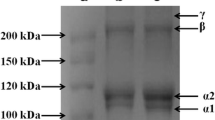Abstract
A translucent collagen gel was formed from a transparent acidic solution of red stingray collagen by adjusting to physiological ionic strength and pH in phosphate buffer and then incubating at 25–37°C. During fibril formation from red stingray collagen, the turbidity increased when the NaCl concentration was increased at constant pH and the rate of fibril formation was accelerated by higher pH or lower NaCl concentration. The T m of red stingray collagen fibrillar gel was estimated as 44.3 ± 3.5°C, which was higher than that of the collagen solution, 33.2°C. In addition, red stingray collagen gel maintained its shape without melting and was suitable for culture of mouse stromal cells at 37°C.





Similar content being viewed by others

References
Morimura S, Nagata H, Uemura Y, Fahmi A, Shigematsu T, Kida K (2002) Development of an effective process for utilization of collagen from livestock and fish waste. Process Biochem 37:1403–1412
Swatschek D, Schatton W, Kellermann J, Muller WEG, Kreuter J (2002) Marine sponge collagen: Isolation, characterization and effects on the skin parameters surface-pH, moisture and sebum. Eur J Pharm Biopharm 53:107–113
Muyonga JH, Cole CGB, Duodu KG (2004) Characterisation of acid soluble collagen from skins of young and adult Nile perch (Lates niloticus). Food Chem 85:81–89
Nagai T, Yamashita E, Taniguchi K, Konamori N, Suzuki N (2001) Isolation and characterization of collagen from the outer skin waste material cuttlefish (Sepia lycidas). Food Chem 72:425–429
Nagai T, Araki Y, Suzuki N (2002) Collagen of the skin of ocellate puffer fish (Takifugu rubripes). Food Chem 78:173–177
Senaratne LS, Park PJ, Kim SK (2006) Isolation and characterization of collagen from brown backed toadfish (Lagocephalus gloveri) skin. Bioresour Technol 97:191–197
Kadler KE, Holmes DF, Trotter JA, Chapman JA (1996) Collagen fibril formation. Biochem J 316:1–11
Nomura Y, Toki S, Ishii Y, Shirai K (2000) Improvement of the material property of shark type I collagen by composing with pig type I collagen. J Agric Food Chem 48:6332–6336
Yunoki S, Nagai N, Suzuki T, Munekata M (2004) Novel biomaterial from reinforced salmon collagen gel prepared by fibril formation and cross-linking. J Biosci Bioeng 98:40–47
Bae I, Osatomi K, Yoshida A, Osako K, Yamaguchi A, Hara K (2008) Biochemical properties of acid-soluble collagens extracted from the skins of underutilised fishes. Food Chem 108:49–54
Gross J, Kirk D (1958) The heat precipitation of collagen from neutral salt solutions: some rate regulating factors. J Biol Chem 233:355–360
Williams BR, Gelman RA, Poppke DC, Piez KA (1978) Collagen fibril formation. J Biol Chem 253:6578–6585
Nomura Y, Toki S, Ishii Y, Shirai K (2002) The physicochemical property of shark type I collagen gel and membrane. J Agric Food Chem 48:2028–2032
Nagai N, Yunoki S, Satoh Y, Tajima K, Munekata M (2004) A method of cell sheet preparation using collagenase digestion of salmon atelocollagen fibrillar gel. J Biosci Bioeng 98:493–496
Nomura Y, Kitazume N (2002) Use of shark collagen for cell culture and zymography. Biosci Biotechnol Biochem 66:2673–2676
Ohneda O, Yanai N, Obinata M (1990) Microenvironment created by stromal cells is essential for a rapid expansion of erythroid cells in mouse fetal liver. Development 110:379–384
Nagai N, Mori K, Satoh Y, Takahashi N, Yunoki S, Tajima K, Munekata M (2007) In vitro growth and differentiated activities of human periodontal ligament fibroblasts cultured on salmon collagen gel. J Biomed Mater Res Part A 82:395–402
Acknowledgments
The authors thank Cell Resource Center for Biomedical Research Institute of Development, Aging, and Cancer, Tohoku University, for providing of mouse stromal cells (FLS 5). This work was supported in part by a Grant-in-Aid for Scientific Research from Nagasaki University, Japan.
Author information
Authors and Affiliations
Corresponding author
Rights and permissions
About this article
Cite this article
Bae, I., Osatomi, K., Yoshida, A. et al. Characteristics of a self-assembled fibrillar gel prepared from red stingray collagen. Fish Sci 75, 765–770 (2009). https://doi.org/10.1007/s12562-009-0085-1
Received:
Accepted:
Published:
Issue Date:
DOI: https://doi.org/10.1007/s12562-009-0085-1



